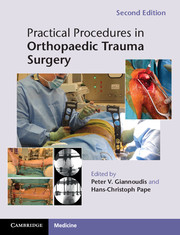Book contents
- Frontmatter
- Dedication
- Contents
- List of Contributors
- Preface
- Acknowledgements
- Part 1 Shoulder girdle
- Part 2 Upper extremity
- 3 Section I: Fractures of the proximal humerus
- 4 Section I: Fractures around the elbow
- 5 Section I: Fractures of the proximal radius
- 6 Fractures of the wrist
- 7 Section I: Fractures of the first metacarpal
- Section II: Fractures of metacarpals II–V
- Section III: Fractures of the phalanx
- Part 3 Pelvis and acetabulum
- Part 4 Lower extremity
- Part 5 Spine
- Part 6 Tendon injuries
- Part 7 Compartments
- Index
Section II: Fractures of metacarpals II–V
Published online by Cambridge University Press: 05 February 2014
- Frontmatter
- Dedication
- Contents
- List of Contributors
- Preface
- Acknowledgements
- Part 1 Shoulder girdle
- Part 2 Upper extremity
- 3 Section I: Fractures of the proximal humerus
- 4 Section I: Fractures around the elbow
- 5 Section I: Fractures of the proximal radius
- 6 Fractures of the wrist
- 7 Section I: Fractures of the first metacarpal
- Section II: Fractures of metacarpals II–V
- Section III: Fractures of the phalanx
- Part 3 Pelvis and acetabulum
- Part 4 Lower extremity
- Part 5 Spine
- Part 6 Tendon injuries
- Part 7 Compartments
- Index
Summary
Indications
Most metacarpal fractures are amenable to closed reduction and plaster immobilization. Definite indications for operative treatment include (Fig. 7.4.1):
Open fractures.
Multiple fractures (stabilizing effect of the adjacent metacarpals is lost).
Unstable fractures (border metacarpals).
Fractures with rotational malalignment (spiral and oblique fractures).
Fractures in polytrauma victims (early mobilization required).
Preoperative planning
Clinical assessment
Pain, swelling and ecchymosis around the metacarpus.
Assess and document neurovascular status.
Assess and document rotational alignment, axis and range of motion of fingers.
Radiological assessment
Anteroposterior, lateral and oblique views.
A 30-degree pronated lateral view for second and third metacarpals and a 30-degree supinated lateral view for fourth and ith metacarpals are helpful.
Preoperative consent
Obtain informed consent from the patient, including but not limited to risks, beneits, alternatives, complications and potential outcome.
Operative treatment
The World Health Organization (WHO) Surgical Safety Checklist should be used in the operating room.
Anaesthesia
Regional or general anaesthesia.
Preoperative prophylactic antibiotics as per local hospital/unit protocol.
Table and equipment
Hand instrumentation set.
Small or mini-fragment instrumentation set.
Arm table.
Pneumatic arm tourniquet.
Fluoroscopic C-arm.
- Type
- Chapter
- Information
- Practical Procedures in Orthopaedic Trauma Surgery , pp. 165 - 169Publisher: Cambridge University PressPrint publication year: 2014



